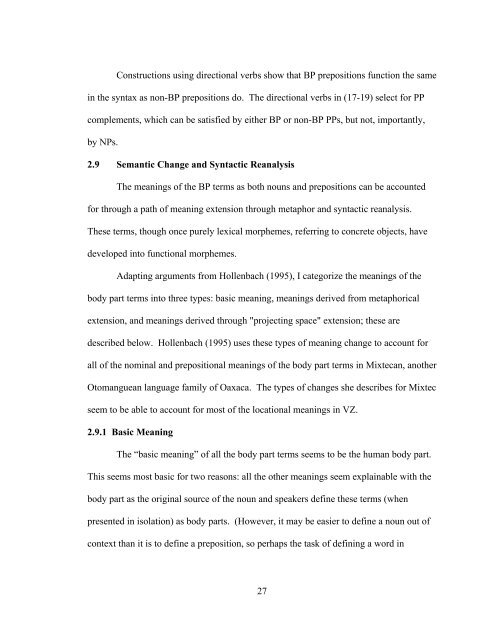The Categorial Status of Body Part Prepositions in Valley Zapotec ...
The Categorial Status of Body Part Prepositions in Valley Zapotec ...
The Categorial Status of Body Part Prepositions in Valley Zapotec ...
Create successful ePaper yourself
Turn your PDF publications into a flip-book with our unique Google optimized e-Paper software.
Constructions us<strong>in</strong>g directional verbs show that BP prepositions function the same<br />
<strong>in</strong> the syntax as non-BP prepositions do. <strong>The</strong> directional verbs <strong>in</strong> (17-19) select for PP<br />
complements, which can be satisfied by either BP or non-BP PPs, but not, importantly,<br />
by NPs.<br />
2.9 Semantic Change and Syntactic Reanalysis<br />
<strong>The</strong> mean<strong>in</strong>gs <strong>of</strong> the BP terms as both nouns and prepositions can be accounted<br />
for through a path <strong>of</strong> mean<strong>in</strong>g extension through metaphor and syntactic reanalysis.<br />
<strong>The</strong>se terms, though once purely lexical morphemes, referr<strong>in</strong>g to concrete objects, have<br />
developed <strong>in</strong>to functional morphemes.<br />
Adapt<strong>in</strong>g arguments from Hollenbach (1995), I categorize the mean<strong>in</strong>gs <strong>of</strong> the<br />
body part terms <strong>in</strong>to three types: basic mean<strong>in</strong>g, mean<strong>in</strong>gs derived from metaphorical<br />
extension, and mean<strong>in</strong>gs derived through "project<strong>in</strong>g space" extension; these are<br />
described below. Hollenbach (1995) uses these types <strong>of</strong> mean<strong>in</strong>g change to account for<br />
all <strong>of</strong> the nom<strong>in</strong>al and prepositional mean<strong>in</strong>gs <strong>of</strong> the body part terms <strong>in</strong> Mixtecan, another<br />
Otomanguean language family <strong>of</strong> Oaxaca. <strong>The</strong> types <strong>of</strong> changes she describes for Mixtec<br />
seem to be able to account for most <strong>of</strong> the locational mean<strong>in</strong>gs <strong>in</strong> VZ.<br />
2.9.1 Basic Mean<strong>in</strong>g<br />
<strong>The</strong> “basic mean<strong>in</strong>g” <strong>of</strong> all the body part terms seems to be the human body part.<br />
This seems most basic for two reasons: all the other mean<strong>in</strong>gs seem expla<strong>in</strong>able with the<br />
body part as the orig<strong>in</strong>al source <strong>of</strong> the noun and speakers def<strong>in</strong>e these terms (when<br />
presented <strong>in</strong> isolation) as body parts. (However, it may be easier to def<strong>in</strong>e a noun out <strong>of</strong><br />
context than it is to def<strong>in</strong>e a preposition, so perhaps the task <strong>of</strong> def<strong>in</strong><strong>in</strong>g a word <strong>in</strong><br />
27

















